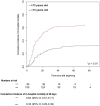Outcomes of COVID-19 patients intubated after failure of non-invasive ventilation: a multicenter observational study
- PMID: 34489504
- PMCID: PMC8421335
- DOI: 10.1038/s41598-021-96762-1
Outcomes of COVID-19 patients intubated after failure of non-invasive ventilation: a multicenter observational study
Abstract
The efficacy of non-invasive ventilation (NIV) in acute respiratory failure secondary to SARS-CoV-2 infection remains controversial. Current literature mainly examined efficacy, safety and potential predictors of NIV failure provided out of the intensive care unit (ICU). On the contrary, the outcomes of ICU patients, intubated after NIV failure, remain to be explored. The aims of the present study are: (1) investigating in-hospital mortality in coronavirus disease 2019 (COVID-19) ICU patients receiving endotracheal intubation after NIV failure and (2) assessing whether the length of NIV application affects patient survival. This observational multicenter study included all consecutive COVID-19 adult patients, admitted into the twenty-five ICUs of the COVID-19 VENETO ICU network (February-April 2020), who underwent endotracheal intubation after NIV failure. Among the 704 patients admitted to ICU during the study period, 280 (40%) presented the inclusion criteria and were enrolled. The median age was 69 [60-76] years; 219 patients (78%) were male. In-hospital mortality was 43%. Only the length of NIV application before ICU admission (OR 2.03 (95% CI 1.06-4.98), p = 0.03) and age (OR 1.18 (95% CI 1.04-1.33), p < 0.01) were identified as independent risk factors of in-hospital mortality; whilst the length of NIV after ICU admission did not affect patient outcome. In-hospital mortality of ICU patients intubated after NIV failure was 43%. Days on NIV before ICU admission and age were assessed to be potential risk factors of greater in-hospital mortality.
© 2021. The Author(s).
Conflict of interest statement
The authors declare no competing interests.
Figures




References
-
- Hernandez-Romieu AC, Adelman MW, Hockstein MA, Robichaux CJ, Edwards JA, Fazio JC, et al. Timing of intubation and mortality among critically Ill coronavirus disease 2019 patients: a single-center cohort study. Crit. Care Med. 2020;48(11):e1045–e1053. doi: 10.1097/CCM.0000000000004600. - DOI - PMC - PubMed
Publication types
MeSH terms
LinkOut - more resources
Full Text Sources
Medical
Miscellaneous

